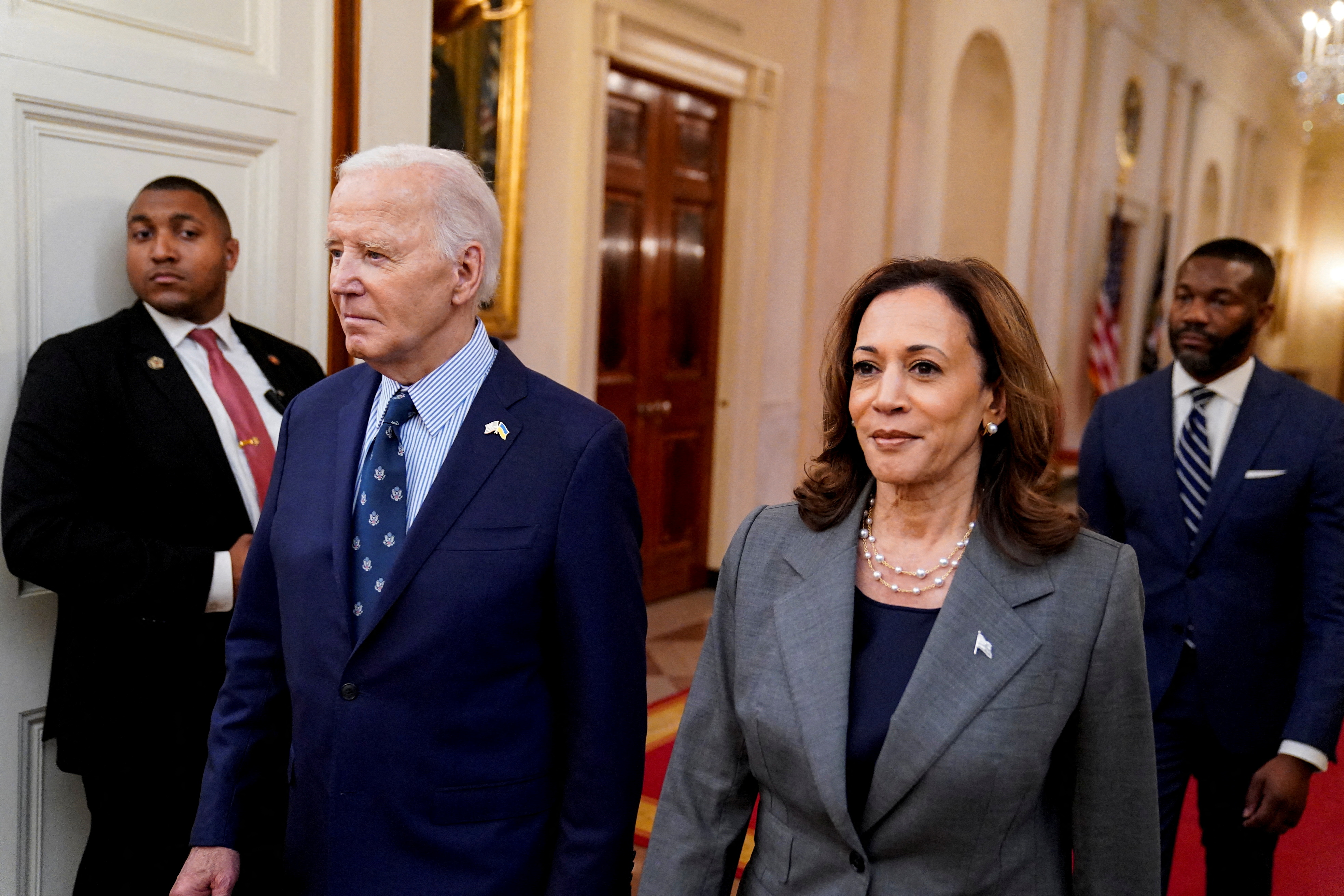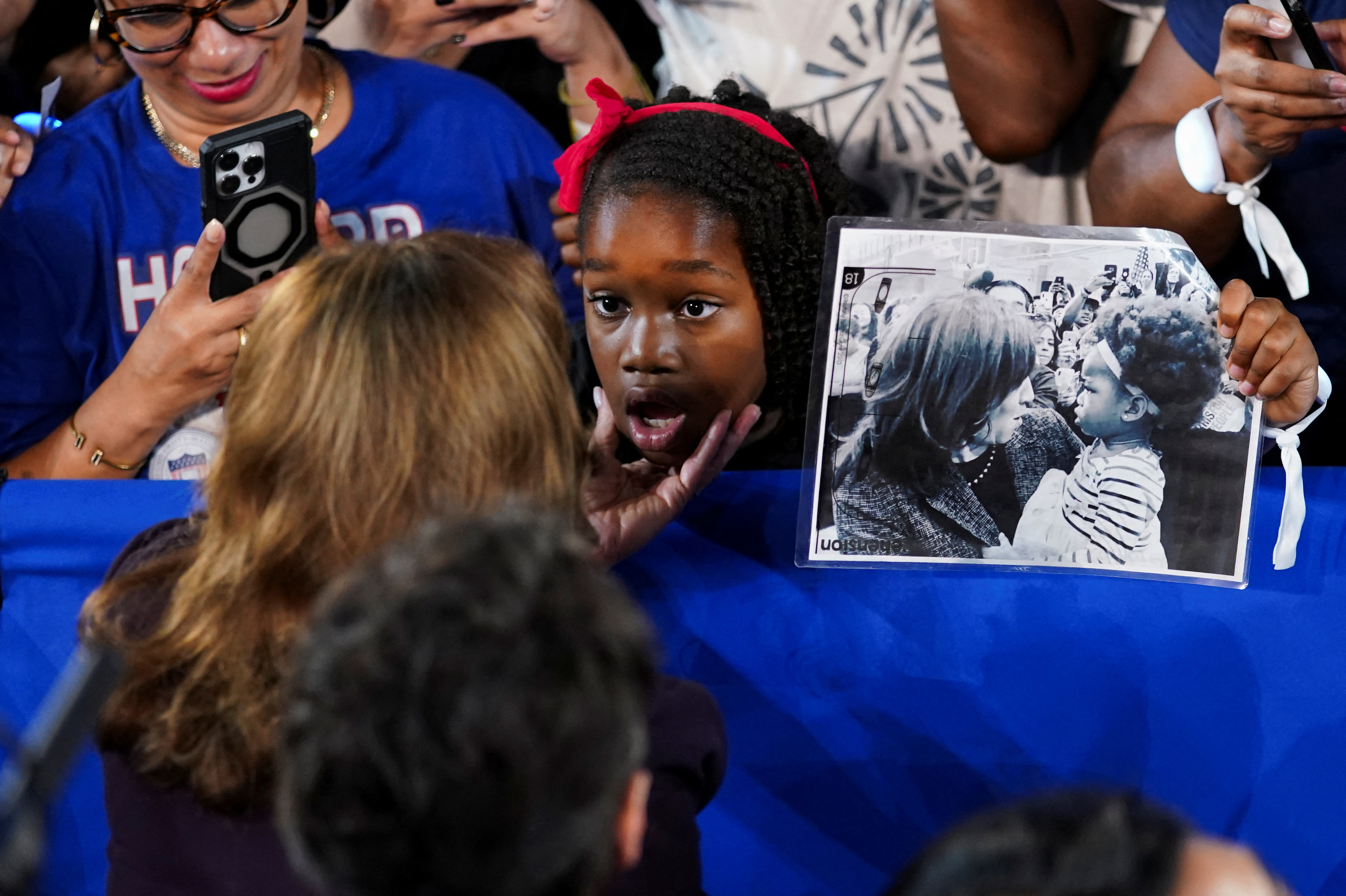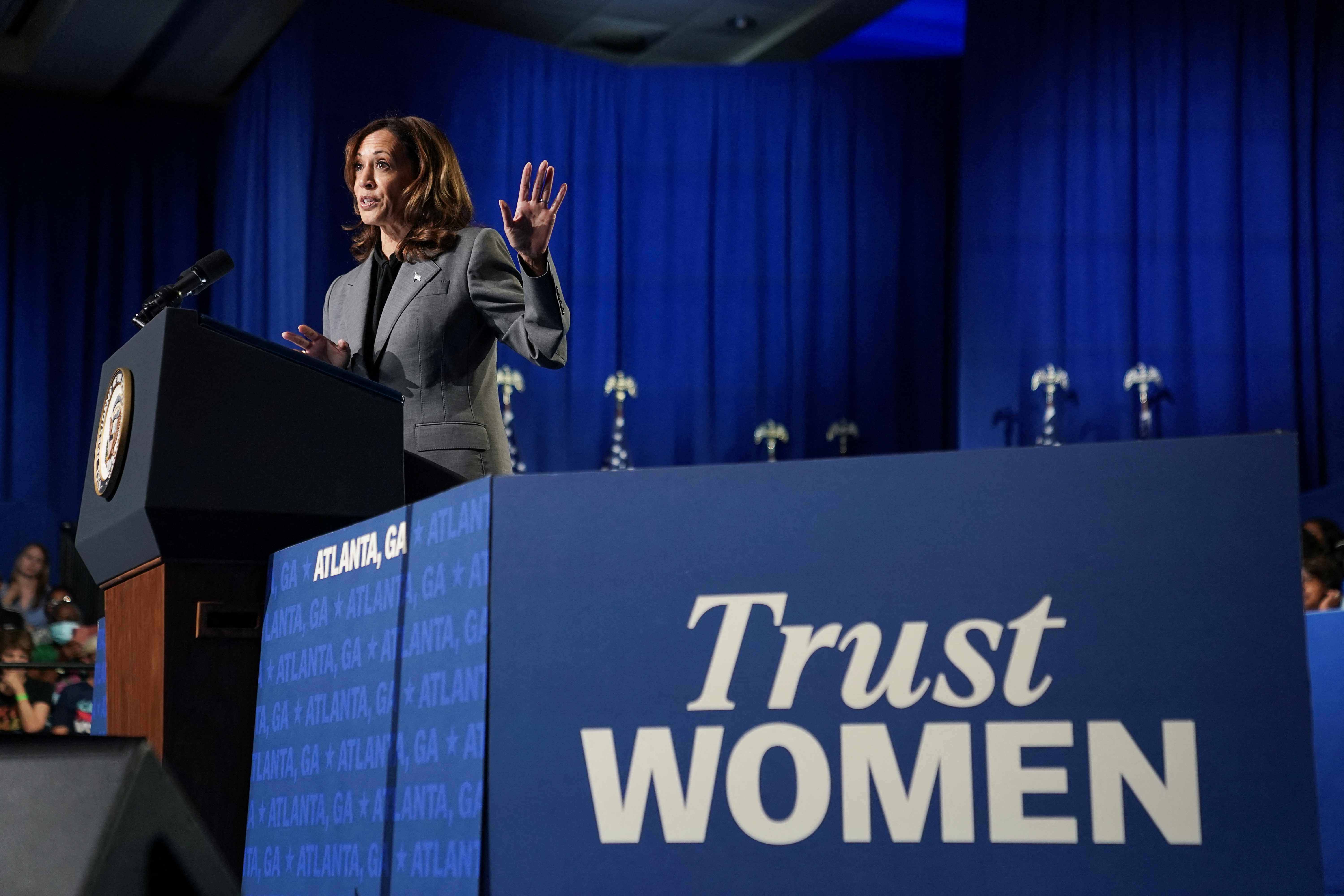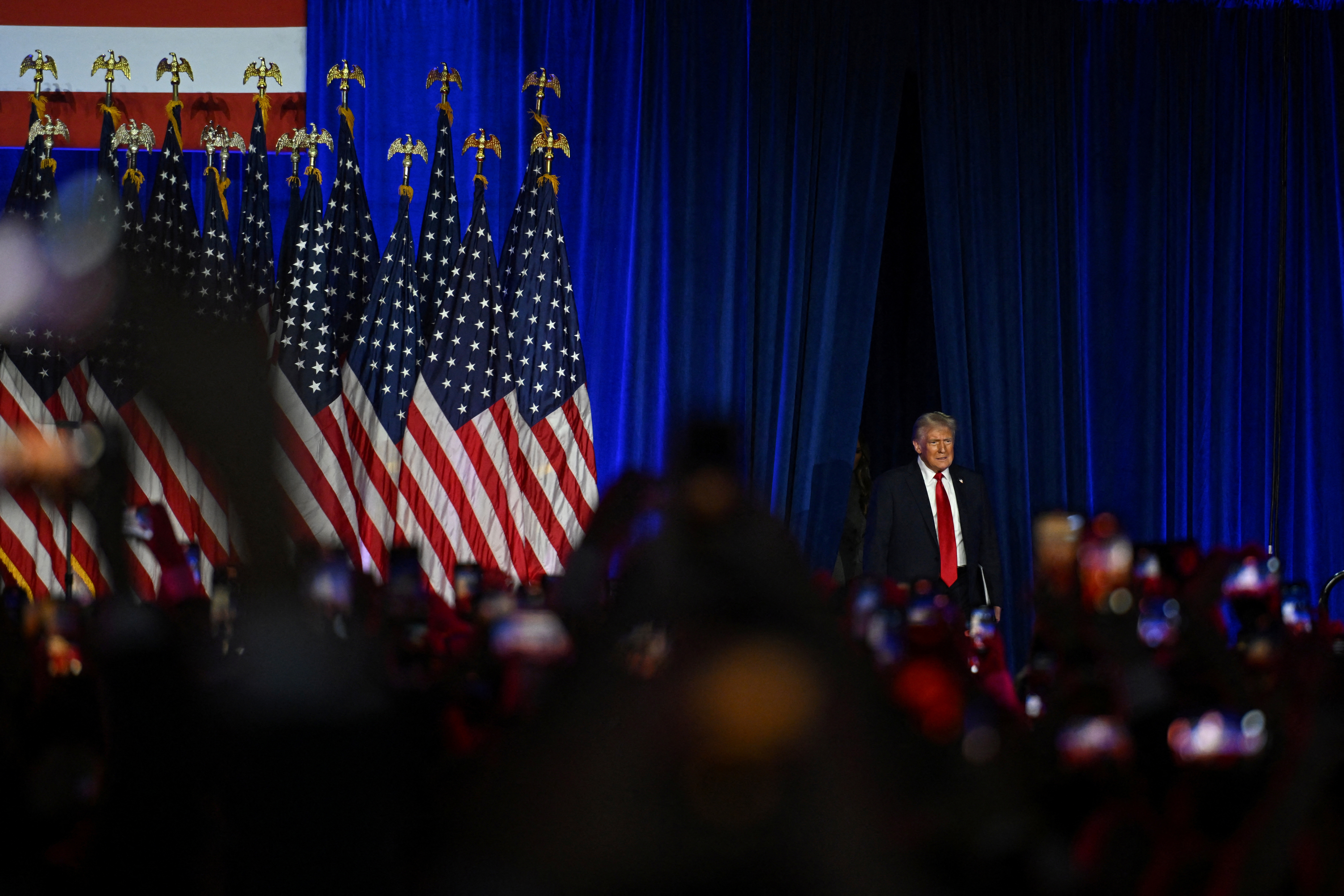Donald Trump reshaped the U.S. electorate again this year, piling up support among Hispanic voters, young people, and Americans without college degrees -- and winning more votes in nearly all of the country as he reclaimed the presidency.
Following the Republican's populist campaign, in which he promised to shield workers from global economic competition and offered a wide range of tax-cut proposals, Trump's increasing strength among working-class voters and nonwhite Americans helped grow his share of the vote almost everywhere.
The starkest increase may have been the 14-percentage-point swing in Trump's share of Hispanic voters, according to an exit poll conducted by Edison Research. Some 46% of self-identified Hispanic voters picked Trump, up from 32% in the 2020 election when Trump lost to Democrat Joe Biden.
Hispanics have largely favored Democrats for decades, but Trump's share this year was the highest for a Republican presidential candidate in exit polls going back to the 1970s, and just higher than the 44% share won by Republican George W. Bush in 2004, according to data compiled by the American Enterprise Institute, a conservative think tank.
In counties where more than 20% of voting-age Americans were Hispanic, Trump's margin over Democratic Vice President Kamala Harris improved by 13 points relative to his 2020 performance against Biden.

"Young Hispanics do not have the same muscle memory as their grandparents who voted for Democrats for 50 years," said Giancarlo Sopo, a Republican media strategist who worked on Hispanic outreach for Trump's 2020 campaign.
This time, Trump won 55% of Hispanic men, 19 points more than the 36% share he won four years earlier, while he garnered support from 38% of Hispanic women, up 8 points from 2020.
Trump has made opposition to immigration a cornerstone of his political career, pledging to conduct mass deportations of people living in the U.S. illegally. Many Hispanic voters supported Trump's hardline positions, according to the Edison Research exit poll. About a quarter of Hispanic respondents said most immigrants in the country without documentation should be deported to the countries they came from, compared with 40% of voters overall in the poll.
ECONOMIC CONCERNS
Hispanic Americans skew more working-class than the country's white majority, with larger shares of Hispanics lacking college degrees, according to U.S. Census Bureau estimates.
Hispanics also tend to be younger than average in America, which means many have had less time to build wealth and have also been more exposed to the economic troubles of recent years, including high inflation and soaring interest rates for mortgages. Trump won 43% of voters aged 18 to 29 - 7 points more than in 2020.
About two-thirds of voters considered the U.S. economy in poor shape, compared with about half of 2020 voters. Some 46% said their family's financial situation was worse than four years ago, compared with 20% who said the same in 2020.
"Republicans have consistently beat Democrats on connecting with voters on the economy," said Clarissa Martinez De Castro, vice president of the nonpartisan UnidosUS Latino Vote Initiative. "This was a referendum on the economy, and that has consistently been the number one, two, and three issues for Hispanic voters."
In the battleground state of Arizona, a state Biden won in 2020, Mexican-born Arturo Laguna became an American citizen earlier this year and cast his first U.S. presidential ballot for Trump, citing the Republican's conservatism and his embrace of restrictions on abortion access.
"The three biggest things of importance are family values, being pro-life, and religion," said Laguna, a 28-year-old corporate manager. "I don't feel like Kamala represents those values."
Across the country, in places where almost all votes were counted - roughly 2,200 counties nationwide - Trump's margin was 5 points higher than it was in 2020.

This broad increase - a rise of the Republican tide - in part owed to Trump's gains among voters without college degrees, a massive class of voters that spans racial and ethnic categories and made up just over half of the electorate on Tuesday.
Some 56% of voters without degrees picked Trump, up 6 points from the Republican's share in the 2020 exit poll. Harris won 55% of voters who have degrees, unchanged from Biden's share in 2020 when affluent suburbs helped power the Democrat's victory.
Trump's gains build on major shifts in the electorate since his triumph in the 2016 presidential election, when he outperformed past Republicans by far among working-class white voters. He largely maintained his dominance with the group this year, winning 66% of their vote, with his share down 1 point from 2020, according to the Edison Research exit poll.
Among people without college degrees and who are not white, however, Trump's share of the vote increased by 8 points.
While Trump gained ground in vote tallies across most of the country, some of his biggest advances were in and around big cities, areas that have been critical for past Democratic victories.
Trump flipped Nassau County - just east of New York City on Long Island - winning about 52 percent of the vote there.
And in the 25 big urban counties where nearly all the votes had been tallied by Wednesday morning, Harris won 60 percent of the vote, down about 5 percentage points from Biden’s performance in 2020 and the lowest share for a Democrat in those counties since at least 2012.
Harris won 53% of the women's vote, while Trump won 55% of the vote by men, with Trump performing slightly better with both groups compared with 2020.
Donald Trump recaptured the White House with a sweeping victory on Wednesday as tens of millions of Americans looked past his criminal charges and divisive rhetoric to embrace a leader who, if he carries out his campaign promises, will test the limits of presidential power.
Trump, 78, clinched Tuesday's election after a polarizing and dizzying campaign marked by two attempts on his life and Kamala Harris' late entry into the race following President Joe Biden's surprise withdrawal.
In a concession speech at her alma mater Howard University on Wednesday afternoon, Harris sought to console the voters who had hoped she would become the first woman to win the White House.
"To everyone who is watching, do not despair," she said. "This is not a time to throw up our hands. This is a time to roll up our sleeves."
Harris said she had called Trump to congratulate him and promised to aid his transition. But she was not prepared to embrace his vision for the country.
"While I concede this election, I do not concede the fight that fueled this campaign," she said, as some supporters in the crowd shed tears. "The fight for freedom, for opportunity, for fairness and the dignity of all people."
At least 200 people gathered outside the Trump International Hotel and Tower in Chicago to protest his election. One banner at the front read "Trump out!" as demonstrators also called for and end to Israel's Gaza incursion, pictures on social media showed.
Biden planned to address the nation at 11 a.m. EST (1600 GMT) on Thursday. The White House said Biden was committed to a smooth transition between now and Trump's inauguration on Jan. 20.
Trump's campaign said Biden called Trump to congratulate him and invite him to a meeting at the White House at an unspecified time.
Trump's resounding victory underscored how disenchanted Americans had become with the economy, border security and the direction of the country and its culture. Voters demanded a change, even if the agent of change was a convicted felon twice impeached and no longer the Washington outsider he was in his 2016 campaign.
Trump has said he wants the authority to fire civil servants he views as disloyal and has vowed to use federal law enforcement agencies to investigate or prosecute perceived enemies, including political rivals.
Trump promised roles in his administration to Tesla CEO Elon Musk, the world's richest man and a prominent Trump donor, and former presidential candidate Robert F. Kennedy Jr.
Musk contributed at least $119 million to a pro-Trump spending group, giving him extraordinary influence to help his companies secure favorable government treatment.
The outcome defied polls that showed a razor-close race ahead of Tuesday's Election Day. Trump prevailed in at least five of the seven battleground states to push him over the 270 Electoral College votes needed to win the presidency and was leading in the remaining two, Arizona and Nevada, where votes were still being tallied.
Trump was also on track to become the first Republican presidential candidate to win the popular vote since George W. Bush two decades ago.
His fellow Republicans wrested control of the U.S. Senate from Democrats and had added to their narrow majority in the U.S. House of Representatives, though the outcome there may not be known for several days with dozens of races still uncalled.
"It was a hell of a good day," said Mitch McConnell, the longtime Senate Republican leader.
[1/15]Republican presidential nominee and former U.S. President Donald Trump takes the stage following early results from the 2024 U.S. presidential election in Palm Beach County Convention Center, in West Palm Beach, Florida, U.S., November 6, 2024. REUTERS/Callaghan O'Hare Purchase Licensing Rights
Unified Republican control on Capitol Hill would clear the way for major portions of Trump's legislative agenda, as it did in the first two years of his 2017-2021 presidency when Republicans whipped a major tax-cut bill through Congress that mainly benefited the wealthy.
"America has given us an unprecedented and powerful mandate," Trump said early on Wednesday to a roaring crowd at the Palm Beach County Convention Center in Florida.
Major stock markets around the world rallied following Trump's victory, while the dollar and bitcoin surged.
OVERCOMING ODDS
Trump was elected despite persistently low approval ratings, four criminal indictments and a civil judgment against him for sexual abuse and defamation. In May, Trump became the first former U.S. president to be convicted of a crime when a New York jury found him guilty on 34 felony counts of falsifying business records to cover up hush money paid to a porn star.
Trump's political career appeared over after his false claims of election fraud led a mob of supporters to storm the U.S. Capitol on Jan. 6, 2021, in a failed bid to overturn his 2020 defeat. His efforts to reverse his defeat led to two separate indictments, though all the criminal cases against him are expected to end after his victory.
Trump swept away challengers inside his party and then beat Harris by capitalizing on voter concerns about high prices and what Trump claimed falsely was a rise in crime due to illegal immigration.
Trump's win will have major implications for U.S. trade and climate change policies, Americans' taxes and immigration, and U.S. foreign policy, including in the Middle East and Ukraine.
Israeli Prime Minister Benjamin Netanyahu congratulated Trump, and they discussed "the Iranian threat" and the need to work together for Israel's security, Netanyahu's office said.
Hamas, the Palestinian militant group, called for an end to the "blind support" for Israel from the United States.
Ukrainian President Volodymyr Zelenskiy welcomed Trump's commitment to "peace through strength," while the Kremlin said it would wait and see if his victory could help end the war in Ukraine more quickly. Trump had said he could end the war in 24 hours but has not offered a detailed plan.
Trump's tariff proposals could spark a fiercer trade war with China and U.S. allies, while his pledges to reduce corporate taxes and implement a spate of new cuts could balloon U.S. debt, economists say.
Chinese President Xi Jinping sent Trump a congratulatory message and said he hopes the two powers will coexist peacefully and achieve win-win cooperation, China's state-run Xinhua news agency reported.
South Korean President Yoon Suk Yeol spoke with Trump and congratulated him, as officials at the trade ministry in Seoul swiftly convened meetings to weigh the potential impact of Trump's proposed tariffs.
A second Trump presidency could drive a bigger wedge between Democrats and Republicans on issues such as immigration, race, gender and reproductive rights.
Trump has promised to launch a mass deportation campaign targeting immigrants in the country illegally.
Hispanics, traditionally Democratic voters, and lower-income households hit hardest by inflation helped fuel the victory.
Trump's support among women, whose backing Democrats had counted on, improved from four years ago. And his loyal base of rural, white and non-college educated voters again showed up in force, according to Edison Research exit polls.
Donald Trump's Republicans looked set on Wednesday to possibly win control of both chambers of Congress, giving them sweeping powers for the first time in eight years to ram through a broad agenda of tax and spending cuts, energy deregulation and border security controls.
But it would also force them to confront the dilemma of pursuing a Trump policy plan that could undermine the party's long-proclaimed goal of reining in the government's $35 trillion in debt.
Republicans secured a 52-48 U.S. Senate majority and were on track to expand their narrow House of Representatives majority, although 51 of the House of Representatives' 435 races remained uncalled.
Early priorities are expected to include extending Trump's 2017 tax cuts, funding the wall along the U.S.-Mexico border, cutting unspent funds allocated by Democrats, eliminating the Department of Education and curbing the powers of agencies including the Consumer Financial Protection Bureau, according to Republican lawmakers and aides.
The tax cut proposals Trump made on the campaign trail - from extending the 2017 tax cuts to abolishing tax on tips, overtime and Social Security benefits - could add $7.5 trillion to the nation's debt over the next decade, according to the nonpartisan Committee for a Responsible Federal Budget.
The federal deficit ballooned to $1.833 trillion in fiscal 2024, as interest on the debt exceeded $1 trillion for the first time.
"We are ready to get to work for the American people," House Speaker Mike Johnson said in an early morning social media post.
Trump repeatedly proved himself able to steer the party's agenda during his four years out of power - notably by telling lawmakers to kill a bipartisan immigration bill early this year. Once returned to the Oval Office, his influence within the caucus will only be stronger.
No. 2 House Republican Majority Leader Steve Scalise told Reuters that lawmakers have been working with Trump for months to ensure that they can hit the ground running with "a real aggressive, bold, conservative first 100-day agenda."
He said they aim to recreate the economic growth experienced early in Trump's first term, before the COVID-19 pandemic struck in 2020 and sent the economy into a steep decline.
Republicans point to buoyant gains in federal tax receipts since 2017 as proof that Trump's tax cuts raised revenues and say his current agenda will bring more of the same.
"History has shown when you reduce the overall tax burden on families, not only do their paychecks go up, but the amount of money coming into the federal government actually increases," said Scalise. "As long as you're controlling spending, that economic growth will actually get you more money to help pay down the deficit."
But the revenue increase they cite is in nominal receipts driven by inflation and an expanding economy. That turns into a decline when the size of the economy is taken into account.
"The Trump tax cuts really did cut tax revenue, and what the Republicans are pointing to as phenomenal growth in tax receipts doesn't actually exist," said Marc Goldwein, CRFB senior policy director.
LEGISLATIVE HURDLES
For the past two years, members of the House Republicans' unruly and narrow majority have repeatedly gotten in their own way, voting against bills backed by their leaders and leaving them to rely on Democratic support to approve must-pass bills.
Even a more disciplined Republican majority will face barriers, including the Senate rule known as the filibuster, which requires 60 of its 100 members to agree to pass most legislation, a threshold the new Senate will not clear with Republican votes alone.
A workaround, known as "budget reconciliation," allows the Senate to pass budget-related matters with a simple majority. Republicans used this in the first two years of Trump's first term, as did Democrats during the first two years of President Joe Biden's term, when they had control of Congress.
Yet budget reconciliation is a limited power. Measures passed with this maneuver must be at least plausibly linked to revenues and spending.
In late 2021, the Senate's parliamentarian rejected a bid by Democrats to use reconciliation to grant work permits to millions of immigrants living in the U.S. illegally.
Should the 60-vote filibuster rule block a Trump priority next year, he could call on Senate leaders to do away with it, as he repeatedly pressured them to do early in his first term, and as some Democrats urged early in Biden's term.
Senate Republican leader Mitch McConnell upheld the filibuster against repeated Trump demands to ditch it during the president-elect's first term.
McConnell will now step down as leader. While the top two candidates to replace him - John Thune and John Cornyn - have said the rule will stay, they and others who might seek the role have yet to face Trump's direct pressure.
And McConnell predicted on Wednesday that the filibuster will remain.
"I think the filibuster is very secure," the Kentucky Republican told reporters
In a meeting with one of America’s most powerful unions in September at its Washington headquarters, Vice President Kamala Harris said she’d protect union jobs and workers’ livelihoods better than Donald Trump.
But leaders of the International Brotherhood of Teamsters, long staunchly allied with her Democratic Party, appeared unconvinced. When Harris argued that her Republican rival was no champion of the working class, the union bosses grilled her, questioning whether she and President Joe Biden had done enough for union workers, according to a Teamster leader who recounted the Sept. 16 meeting to Reuters. Within days, the union publicly embarrassed Harris by declining to endorse a Democratic presidential candidate for the first time since 1996.
In the wake of Harris' loss of the 2024 presidential election, her tense exchange with union leaders underscores a critical failure of her campaign: connecting with working-class voters anxious about the economy and high prices.
Following Biden’s dramatic withdrawal just months before Election Day, Harris threw her campaign together as if it were an airplane being built while in flight, her advisers told reporters. The 60-year-old former prosecutor and U.S. senator pressed a case that Trump was a threat to democracy and women’s rights, while promoting a populist economic platform and reproductive freedoms.
Her entrance upended a race that her party had looked set to lose. She made history as the first woman of color at the top of a major party ticket. She triggered a surge in enthusiasm, broke fundraising records – raising $1 billion in less than three months – and drew endorsements from celebrities ranging from pop star Taylor Swift to actor and former California Governor Arnold Schwarzenegger.
But Harris’ campaign ultimately failed to overcome deep-seated voter concerns about inflation and immigration – twin issues that opinion polls showed favored Trump. Her loss underscores a profound shift in American politics over the past decade as blue-collar voters have turned increasingly Republican – a trend Trump appears to have accelerated.
Harris also struggled to counter another Trump-era trend: a torrent of misinformation unprecedented in modern U.S. elections. An avalanche of misrepresentations and falsehoods about her record was spread by the former president and amplified on right-wing websites and media, including conspiracy theories on issues ranging from migrant crime to voter fraud.
When asked by Reuters during the race about misinformation amplified by Trump, his campaign officials typically either repeated the falsehoods or did not respond to requests for comment.
By late Wednesday, Trump had won 294 electoral votes to Harris’ 223, with several states yet to be counted. In her concession speech, she told supporters, many of them in tears, not to give up even in their disappointment. “Sometimes the fight takes a while. That doesn’t mean we won’t win,” she said.
This account of how Harris lost is based on Reuters interviews with Harris campaign staffers, White House officials, Democratic Party advisors and close allies.
It was always going to be a heavy lift. The U.S. has only elected one president – Barack Obama in 2008 and 2012 – who wasn’t a white man. As the daughter of an Indian mother and Jamaican father, Harris had risen higher in the country’s leadership than any other woman.

President Joe Biden and Harris walk to deliver remarks on gun violence at the White House in September. REUTERS/Elizabeth Frantz
The only other woman to get as close as she did – Hillary Clinton, defeated by Trump in 2016 – staked her candidacy in part on becoming the first female president. In the wake of Clinton’s loss, Harris resisted putting her identity at the center of her campaign, said close aides and advisors. Instead, she tried to galvanize voters on issues that mattered to women and Black voters in the election – from abortion rights to middle-class tax cuts and housing affordability.
But those messages struggled to break through at a time when many voters were fixated on rising consumer prices during the first three years of the Biden administration.
“Despite fairly strong economic growth, especially after a major global pandemic, most Americans weren’t feeling like they were getting ahead economically,” said Melissa Deckman, a political scientist and chief executive of Public Religion Research Institute, a nonpartisan research firm. “The Harris campaign did not necessarily do a good job of explaining how her policies would help the middle class, or at least that message wasn’t really resonating with a lot of voters.”
A majority of voters said they trust Trump more to handle the economy, with 51% saying they did so compared to 47% for Harris, according to a preliminarynational exit poll conducted by data provider Edison Research. And the voters who identified the economy as their primary concern voted overwhelmingly for Trump over Harris - 79% to 20%.
The economy proved to be a much bigger concern among voters than reproductive rights, with 31% of voters saying the economy mattered most in deciding how to vote compared with 14% who cited abortion. The election also saw a large gender gap. Harris won 54% of women voters in the country, while Trump won 44%, the preliminary exit polls showed.
The Harris and Trump campaigns and the White House did not immediately respond to requests for comment.
“America has given us an unprecedented and powerful mandate,” Trump said early on Wednesday to a roaring crowd of supporters at the Palm Beach County Convention Center.
ELECTORAL GOLD
The election was punctuated by dramatic twists, including two assassination attempts against Trump and the stunning decision by Biden to abandon his re-election bid on July 21.
Democrats coalesced behind Harris with astonishing speed, locking up her party’s nomination within two weeks, excited by her potential to flip the generational argument on Trump. Two decades her senior, Trump had successfully cast the 81-year-old Biden as a frail and confused old man. She would turn that on its head, many Democrats hoped.

Harris speaks to a child holding a picture of herself and Harris during a campaign rally in Houston, Texas, in October. REUTERS/Kevin Lamarque
Some Democratic strategists questioned the wisdom of one of her first big decisions: picking Minnesota Governor Tim Walz as running mate over Pennsylvania Governor Josh Shapiro, a deft speaker with proven political strength in a must-win state. Her campaign had hoped the gun-owning Walz, a liberal policy champion and plain-speaking National Guardsman from the Midwest, would help her win over rural white voters.
Walz had generated buzz before Harris picked him by branding Trump and his running mate, Senator JD Vance of Ohio, as “weird” on national television in July, winning Democratic hearts and media attention. Later, though, Walz gained unwelcome attention for misstatements of his biography, including his military service, and for an uneven debate performance against Vance.
Walz and Vance didn’t immediately respond to requests for comment.
Still, the Harris campaign believed her signature issues – reproductive rights and Trump’s divisiveness – would energize a coalition of women, Black voters, young Americans, independents and “Never Trump” Republicans, sweeping her to the White House.
Well before the race began, Harris emerged as a spokesperson for abortion rights. When the U.S. Supreme Court in 2022 officially reversed Roe v. Wade, declaring the constitutional right to abortion no longer existed, the setback for women’s reproductive rights created an unexpected opening for Harris.
The ruling catapulted her from the political periphery into the heart of America’s culture wars. Opinion polls showed most Americans disapproved of the court’s decision – and Harris became the face of an issue that Democratic strategists saw as electoral gold.

Harris speaks about abortion rights at a campaign event in Atlanta, Georgia, in September. REUTERS/Elijah Nouvelage
For the first time in Biden’s presidency, he handed a decisive issue entirely to his vice president. She went on the road, speaking forcefully on a subject that played an outsized role in helping Democrats stave off an expected bloodbath in the 2022 congressional elections. After the midterms, with the Democrats having held the Senate and swung to a slight minority in the House of Representatives, Harris was now seen as a viable future leader in the party.
Still, even after Biden stepped aside, concerns lingered among some top White House aides over the former San Francisco district attorney’s political skills – including a perception that she hadn’t made a mark as VP, her short-lived campaign for the 2020 Democratic nomination and her limited experience courting conservative voters in battleground states. Some also questioned whether she could overcome the long history of racial and gender discrimination in the U.S.
Despite fairly strong economic growth, especially after a major global pandemic, most Americans weren’t feeling like they were getting ahead economically.
Melissa Deckman, political scientist and chief executive of Public Religion Research Institute
After securing the nomination, Harris initially put many of those concerns to rest. She revitalized a beleaguered Democratic campaign, attracting record-high funding and a groundswell of support. She soon moved ahead of Trump in the polls, a sign she was sparking enthusiasm among voters, particularly among women. Trump had previously been seen as the frontrunner, partly based on his perceived strength on the economy after several years of high inflation under Biden.
She aced her first big test – a Sept. 10 televised debate against Trump.
As Harris’s team prepared for what would be her only in-person face-off with Trump, they focused on ways to unnerve the former president and draw attention to his frequent falsehoods on policies, according to several aides involved in the preparations. Harris holed up in Pittsburgh with advisers and conducted mock debates for the prime-time showdown, the aides said.
The strategy paid off. Harris appeared to get under her rival’s skin during the debate. She pressed Trump on the economy, Ukraine, healthcare, the January 2021 Capitol riots and abortion, leaving him rattled and struggling to respond.

Harris listens as she debates former President Donald Trump in September. REUTERS/Brian Snyder
Fundraising spiked: Her campaign said it raised $47 million in the 24 hours after the debate. Most voters thought Harris had won, polls showed. Trump shot down offers for another debate, claiming he’d already beaten her.
On the campaign trail, Harris mocked Trump’s debate performance, including his comment that he had “concepts of a plan” to replace a federal health care law. As she gained in polls, Harris’ campaign believed she was opening up states that had been out of reach for Biden, including North Carolina, where the president had his narrowest loss against Trump in 2020 and where she was drawing even in the polls with Trump.
‘IT COULD COST US THE ELECTION’
North Carolina was the scene of her next big test, the late September Hurricane Helene, one of the deadliest storms to hit the U.S. in the last 50 years. The storm shifted focus from messages at the foundation of Harris’ campaign to the handling of the disaster by the Biden-Harris administration.
It hit just as her lead was narrowing. Trump went on the attack, criticizing the Democratic administration’s response to the disaster and tying it to his strongest issue, immigration. As the death toll rose and swathes of North Carolina lay devastated, Trump amplified and spread falsehoods, including a claim that Harris spent disaster-assistance money on housing illegal migrants.
In response to a recent request for comment by Reuters about false claims about how disaster funds were being used, the Trump campaign repeated accusations that money had been spent on housing migrants in the country illegally.
Harris cut short a campaign swing and flew to Washington on Sept. 30 for a briefing on Biden’s emergency response. On her plane, three staffers sat on the floor, ripping apart briefing books, replacing the pages with new notes, a Reuters reporter witnessed.
The disaster, which killed more than 200 people, marked a shift in the race, as misinformation around the administration’s response and Trump’s hardline rhetoric on immigration gained traction. The baseless claims included that the government covered-up deaths, confiscated charitable donations and diverted disaster funds to help immigrants. Harris’ campaign struggled to address both the false claims and voters’ concerns about an uptick in illegal border crossings during Biden’s presidency.
One jurisdiction that illustrated the risks for Harris was Buncombe County, a North Carolina Democratic stronghold of about 280,000 people hammered by the storm. In its aftermath, Democrats stopped targeting potentially persuadable Republican voters there because of concerns they had become too hostile amid the misinformation, Kathie Kline, Buncombe County Democratic chair, told Reuters. In the end, Trump won the state.
As the race tightened through October, and polls indicated a toss-up, alarm spread among Democratic strategists.
They focused on shoring up the so-called Blue Wall of Democratic states: Michigan, Pennsylvania and Wisconsin. Eight years ago, when Trump beat Hillary Clinton, he breached the Blue Wall by winning all three states, each by less than a percentage point. In 2020, Biden won them back. Holding the Blue Wall now was Harris' best path to the White House, the strategists reasoned. But they had a problem: Michigan and the Gaza War.

Pro-Palestinian uncommitted delegates walk into the Democratic National Convention in August. REUTERS/Vincent Alban
Michigan’s large population of Arab Americans and Muslims helped cement Biden’s 2020 victory in the state. Trump turned off many of these voters in his first term, in part by banning immigration to the U.S. from a number of Muslim countries early in his tenure.
In the race’s final stretch, Muslim and Arab-American voters told Reuters they were disappointed Harris did not distance herself more from Biden’s unwavering support of Israel during the Gaza war. In the final weeks, Trump aggressively courted their vote. Many said they would sit out the election or vote Republican.
Harris staffers knew that disillusioned Muslim and Arab-American Democrats were a risk. “It could cost us the election,” said a senior Michigan operative for Harris in July.
The campaign ultimately concluded it was impossible to fully win back those voters. To offset their loss, campaign officials said they focused in the final weeks on marshaling enough support from union workers and Black voters in Detroit, the nation’s largest Black-majority city.
ECONOMIC THREATS
But few issues threatened Harris like inflation.
Her campaign had hoped the economic recovery from the pandemic would be a winning issue. Growth is markedly more robust in the U.S. than in other major industrial nations. Stock-market indexes are near record highs.
Instead, the issue eroded Democratic support throughout much of 2024 as union workers and non-college-educated white voters broke for Trump, polls showed. Sharp increases in housing and food costs frustrated voters, overshadowing a strong job market. Trump blamed Harris for the spike during her and Biden’s time in office.
While most unions have long supported Democratic candidates, rank-and-file workers in recent years have moved behind Trump, proving a decisive factor in his victory. There were some positive signs for Harris. The AFL-CIO, the largest federation of unions, saw a surge in female members supporting Harris and willing to volunteer for her, AFL-CIO President Liz Shuler told Reuters.
In the final weeks of the race, Harris’ momentum appeared to have stalled, with polls showing her edge over Trump narrowing. By mid-October, the race was a dead heat in crucial states.
A pronounced gap in polling between men and women had emerged, too. While Harris cut away at the Republicans’ longstanding edge with white voters overall by gaining ground with white women, Trump appeared to be boosting his advantage with men.
Harris shifted strategy in an attempt to win over more men and Republicans. The campaign dispatched running mate Walz on a tour in mid-October to reach male voters. Harris also held campaign events with former lawmaker Liz Cheney, one of Trump’s fiercest Republican critics and one of the most prominent conservatives to endorse the Democrat. Days later, Trump suggested Cheney should face gunfire in combat, drawing outrage among Democrats and pundits.

Harris speaks on the National Mall in front of the White House in Washington. REUTERS/Carlos Barria
The vice president also sharpened her attacks on Trump. In an Oct. 29 speech billed as her closing argument, Harris warned of the dangers of another Trump presidency. He was “unstable” and sought “unchecked power,” she told a rally held at the spot in Washington where Trump addressed his supporters before they attacked the U.S. Capitol on Jan. 6, 2021. With a well-lit White House behind her, she cast herself as a defender of democracy, unity, and freedom.
She also sought to reassure voters about the cost of living. She said that Trump’s proposals to raise tariffs would amount to “a 20% national sales tax” on imported goods. She vowed to “protect hard-working Americans who aren’t always seen or heard.”
In the end, not enough of those Americans believed her.

